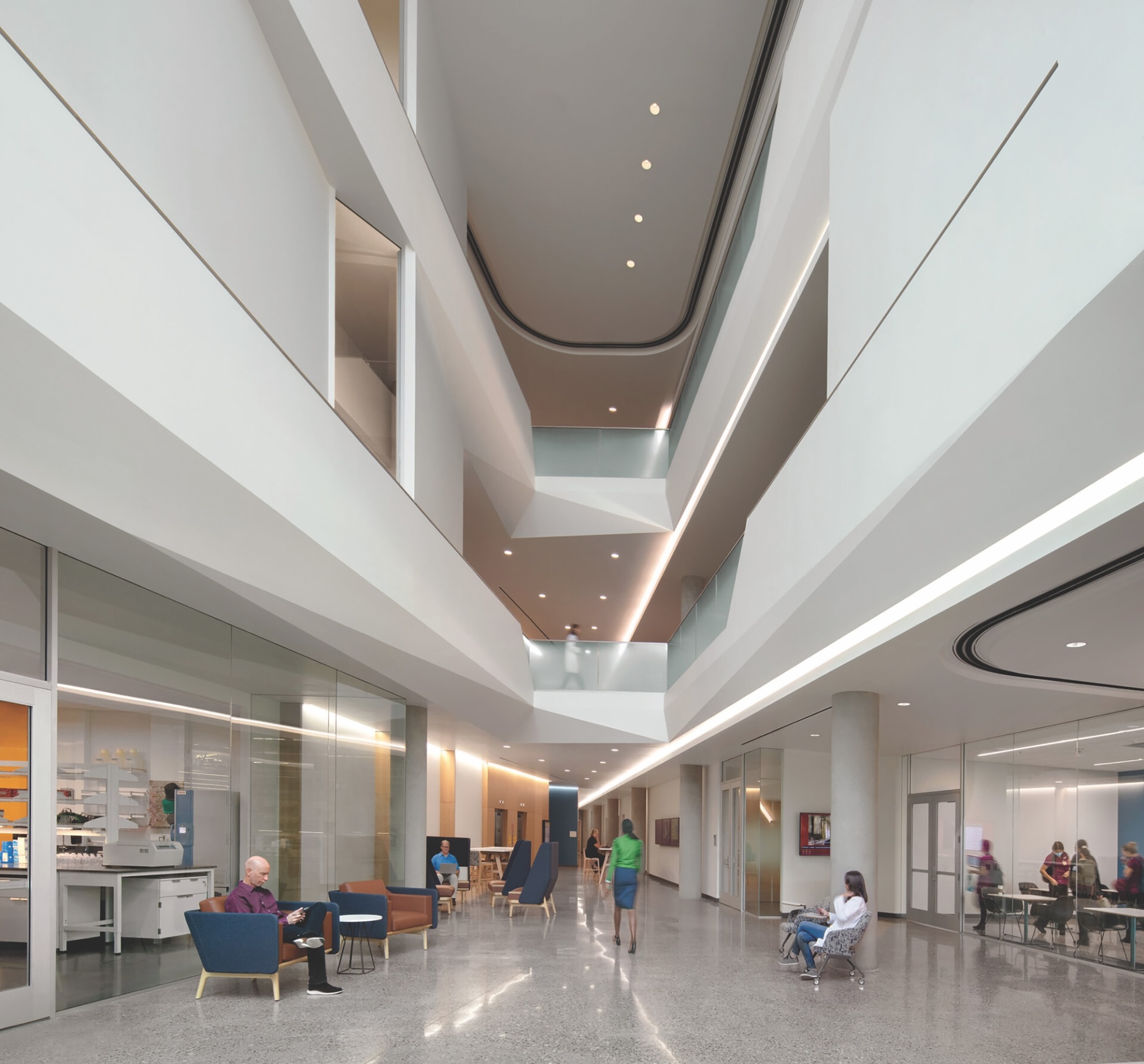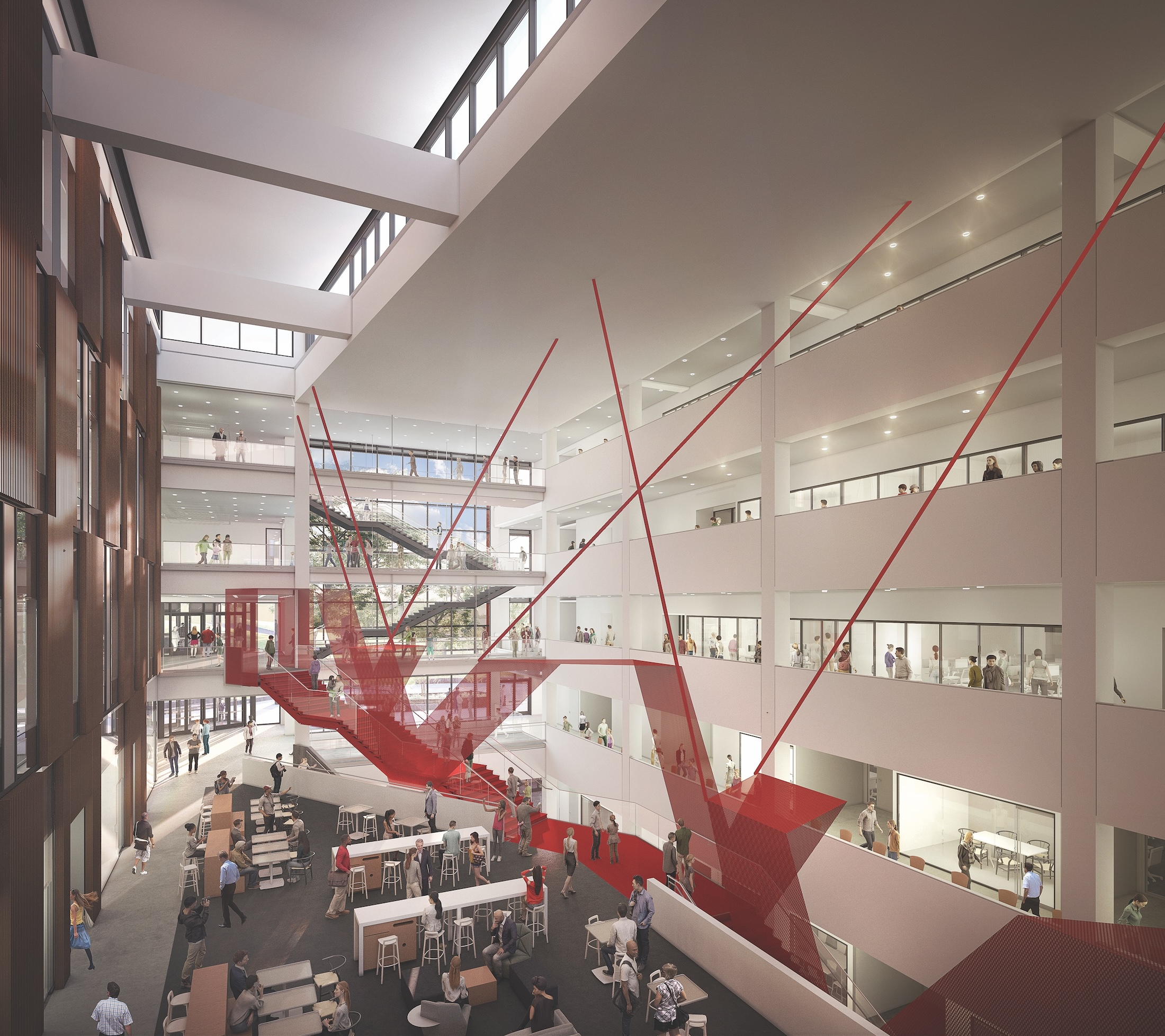Coming out of the Coronavirus-inspired shift in academic learning, many colleges and universities are trying to find ways to attract students back to campus. Will residences, amenities, services do the trick? While they ponder a solution, another issue is burgeoning.
Both public and private academic institutions are evaluating their use of space more than ever. Capital planning, limited available land, and space utilization studies tell them what they need to know: optimization is key. There is a growing desire for buildings that can stand the test of time—ones that offer students something serviceable and special.
Higher education institutions have found a way to hit many birds with one stone. From attracting students, increasing interpersonal engagement, and making the most of pre-existing inventory and land, one design may answer it all: flexible buildings.
Designing Flexible University Buildings
Designing and building flexible university buildings has been a common task among AEC firms throughout 2023. Planning for space that accommodates dynamic programming within 50-year lifecycles is a “universal theme” witnessed this year, according to Greg Fraikor, Higher Education Core Market Leader at DPR Construction. The flexible design of these buildings benefits university leaders and students alike—not only in the way of optimizing space, but also for promoting community, connectivity, and collaboration among end-users. Built to adapt, flexible spaces merge disciplines together in novel ways, something that single-use buildings are not typically designed to do.
Skanska’s Lew Guerrette, Executive Vice President and National Higher Education Advisory Council chair, has seen a trend toward fewer large lecture halls and an increase in labs, multipurpose studios, flexible rooms, and maker spaces. For example, the Rubenstein Arts Center at Duke University incorporates six multipurpose studios that reflect flexibility. Each room can be adapted into an art exhibit, classroom, public program space, and more.
There has even been a slowing demand for traditional libraries, which are being replaced by amenity-driven learning commons facilities, according to Léo Lejeune, LEED AP, Senior Principal and Education Sector Leader with Stantec. These are facilities that not only accommodate the need for quiet study spaces, but also access to technology, group study areas, and dining environments that support large social activities.
While there might not be an official name for these multipurpose buildings, global architecture and design firm Gensler refers to them as an “education ecosystem.” They can be holistic study spaces, cross-college classroom hubs, or even student entertainment and living spaces. One of the rising archetypes, however, correlates to one of the other big trends in higher education planning today: STEM.
STEM University Buildings
STEM buildings like research laboratories, biomedical centers, and health science buildings are the most in demand on campuses. As universities retain a focused interest in STEM learning, even these spaces are being challenged to increase flexibility for students and university partners.
The Architectural Resources Cambridge- and ZGF-designed UMass Chan Medical School’s New Education and Research Building features program and research space—as well as administrative offices, collaboration spaces, and conference rooms. It aims to support all three of the university’s graduate schools with research space that can accommodate more than 70 principal investigators. The flexible space will allow the university to increase class size and open up laboratory space in other campus buildings—aiding in the industry’s appeal for more medical professionals.

“Universities recognize that difficult research problems require multidisciplinary solutions,” says Sam Miller, FAIA, LEED AP, Partner, LMN Architects. As a result, projects that encourage mixing and collaborative research are more common, as are buildings that are flexible and adaptable over time to meet changing needs.
Conversely, firms like Page Southerland Page are seeing a decrease in performing arts facilities and free-standing student unions.
“We interpret this as a pendulum swing due to the interest in STEM core learning … a counterpoint to recent student life-focused improvements luring students to return to campus from our era of remote education,” says Todd Ray, FAIA, LEED AP, Design Director with Page.
While the construction of STEM buildings can be funded in many ways, science buildings are typically the first to be funded by endowments or private donors because of their importance to the university’s future, according to Guerrette.
“When planned thoughtfully, these spaces are designed and built for long-term flexibility, creating interdisciplinary, state-of-the-art facilities,” says Guerrette.
Adaptive Reuse in higher education
With land usage at the forefront of institutions’ minds, capital planning activities like renovations and modernizations are being increasingly considered over new construction. Reusing older single-use buildings into “educational ecosystem” ones can be more economical and sustainable than new construction, according to Gensler Education Leaders Deborah Shepley, AIA, LEED AP, and Mark Thaler, AIA.
“Whether to save money on new construction costs or adhere to seismic building code mandates, adaptive reuse projects are on the rise at colleges and universities,” says Sam Wen, Construction Manager with PCL Construction.
The Stantec-designed New Learning Commons at Kettering University, Flint, Mich., thoughtfully weaves power and technology throughout the building to accommodate alternative configurations. Designing with the future in mind allows spaces to adapt in unforetold ways—even years down the road.
Student Wellness and Student-First Design
Along with the strive to bring students back to campus, projects that emphasize student health and wellness are on the rise in 2023. However, these are becoming more than the stand-alone health centers of the past, according to Chris Purdy, AIA, LEED AP, Vice President and Director of Higher Education, SmithGroup.
“We’re seeing fusion buildings that include mental and physical wellness spaces partnered with other programs—such as housing, dining, recreation, and living/learning—for a more holistic approach,” says Purdy.
The key driver for firms is building a purpose of place. Gensler’s 2022 Education Engagement Index revealed a correlation between students’ relationships with their peers and their perceived success. When students returned to campus post-Coronavirus, the correlation became even more staggering, according to Gensler’s Thaler.
Environments that promote collaboration and community building even lead to student success and retention, according to a College Pulse and Inside Higher Ed survey. Student success centers remain in the conversation as colleges and universities consolidate and grow their resources for students, according to Fraikor.
The LMN Architects-designed Clifton Court Hall at the University of Cincinnati brings together seven academic departments to aid in learning and social engagement. The building will feature a mix of flexible classroom spaces, more than 1,000 classroom seats, and a large community atrium that ties together conference rooms and collaboration spaces.
Student Housing
One of the biggest challenges in higher education today is producing more affordable student housing. Not only do institutions have the goal of increasing the student experience, but they also have to ensure a profitable revenue stream—something that has undoubtedly dwindled since remote and hybrid learning skyrocketed. What’s different now, according to David Damon, AIA, LEED AP, Global Practice Leader for Higher Education at Perkins&Will, is the sheer scale and ambition of many of these projects.
“Many universities are investing in the development of large-scale new student housing facilities,” says Damon. “These facilities typically offer more amenities and conveniences, attracting students and potentially generating more revenue through increased occupancy rates.”
Attaching services to on-campus housing—dining areas, mental health services, study spaces, and student success centers—almost treats the space as a “transformed” student union building, says Shepley.
When it’s not new construction, student housing renovation projects remain steady as universities and schools look to better adapt to evolving student needs, according to Ron Simoneau, LEED AP, DBIA, CM LEAN, Executive Vice President of Education with Shawmut Design and Construction.
The end goal is this: Provide an improved experience for higher education students. The decline in single-use buildings is well under way. What flex spaces are the most optimal, and what the future of flex buildings looks like, are still questions that remain without definitive answers.
Related Stories
| Aug 11, 2010
Northeast Lakeview College opens in Texas, to serve 15,000 students
After four years of construction, Northeast Lakeview College, the newest addition to Alamo Colleges, is complete. Designed by Overland Partners Architects in collaboration with Ford Powell & Carson, the nine-building, 285-acre campus in Universal City, near San Antonio, will serve up to 15,000 students.
| Aug 11, 2010
Dual physics buildings aim for LEED Silver
Two new physics buildings providing 197,000 sf of teaching, study, and office space are opening at Texas A&M University. The $82.5-million George P. Mitchell '40 Physics Building and the George P. and Cynthia Woods Mitchell Institute for Fundamental Physics and Astronomy offer new research laboratories, graduate and undergraduate lounges, offices, a 468-seat lecture hall, and a 180-seat aud...
| Aug 11, 2010
University building gets revamped, reused
KSS Architects of Philadelphia is designing the addition and renovation to SUNY Cortland's Studio West, a 43,000-sf metal panel and brick building dating to 1948. The 20,000-sf, two-story addition will become the Professional Studies Building, housing the consolidated departments of Recreation, Parks, and Leisure Studies; Communications Disorders and Sciences; and Kinesiology and Sports Managem...
| Aug 11, 2010
Project is music to school's ears
Florida Gulf Coast University is building a $7.55 million Fine Arts Building on its campus near Ft. Myers, Fla. The 25,000-sf building—the first project in the school's plan for an entire music complex—will house the music program of the College of Arts and Sciences. The facility includes a 200-seat recital hall, rehearsal hall, music labs, studio rooms, and administration offices.
| Aug 11, 2010
BU students move into high-rise dorm
Boston University’s newest residential building rises 26 stories above the Charles River. Part of the school’s 10-acre John Hancock Student Village, the 396,000-sf tower houses 962 students and has three apartments for faculty use. The tower also has a large multipurpose room on the top floor.
| Aug 11, 2010
Expansion of chemistry facility no experiment
A September ground breaking at Wayne State University in Detroit puts the school’s A. Paul Schaap Chemistry Building and Lecture Hall on track for a December 2010 completion. The $37 million, 96,000-sf facility is the second phase of a two-phase project to expand and renovate the existing chemistry building.
| Aug 11, 2010
Polshek unveils design for University of North Texas business building
New York City-based architect Polshek Partnership unveiled its design scheme for the $70 million Business Leadership Building at the University of North Texas in Denton. Designed to provide UNT’s 5,600-plus business majors with a state-of-the-art learning environment, the 180,000-sf facility will include an open atrium, an internet café, and numerous study and tutoring rooms—al...
| Aug 11, 2010
Cooper Union academic building designed to reach LEED Platinum
Morphosis Architects and Gruzen Samton are collaborating on an ultra-green academic building for New York’s Cooper Union that is designed to achieve LEED Platinum certification. The program for the nine-story facility mixes state-of-the-art laboratories, classrooms, a multipurpose auditorium, and a range of public and social spaces.
| Aug 11, 2010
Utah research facility reflects Native American architecture
A $130 million research facility is being built at University of Utah's Salt Lake City campus. The James L. Sorenson Molecular Biotechnology Building—a USTAR Innovation Center—is being designed by the Atlanta office of Lord Aeck & Sargent, in association with Salt-Lake City-based Architectural Nexus.
| Aug 11, 2010
Construction begins on Louisiana State Sports Hall of Fame
Heavy construction and foundation work has started on the new Louisiana State Sports Hall of Fame and Regional History Museum in Natchitoches, La. Designed by Trahan Architects, Baton Rouge, the $12 million, 28,000-sf museum will be clad in sinker cypress planks as a nod to the region’s rich timber legacy and to help control light, views, and ventilation throughout the facility.







